Balance and Coordination

Does your child have difficulties with Movement, Balance and Co-ordination?
Some children have difficulty organising and co-ordinating their movements and may be described as ‘clumsy.’ You may notice that they may bang into furniture and trip over things more often when moving around. They may find gross motor activities such as running, balancing on one leg or along a straight line, hopping, climbing, kicking and throwing and catching more difficult which has an impact on their success and participation with skills such as riding a bike, climbing a climbing frame and various sports.What is Balance?
Balance is a biological system which allows us to know where our bodies are in the environment and to maintain a desired position. Normal balance is dependent on information from our hearing, our senses (such as sight and touch), and muscle movement.
What is Coordination?
Coordination involves two or more organs (e.g., hands, eyes, legs, etc.,) within a living thing interacting and complementing the functions of one another.
What is the impact of these difficulties?
- It can be worrying for parents or carers when their child is frequently injuring themselves and it feels like they are always being sent home from school with an ‘injury’ note.
- It can be frustrating and disheartening for children if they are not as successful as their friends when participating in physical activities which can have an impact on their self esteem and confidence.
- Children may be more likely to avoid taking part in age appropriate physical activities such as sports, climbing, scooting and bike riding. Taking part in physical activity is important because:
- It helps children stay strong, fit and maintain a healthy body weight
- It builds friendships and supports mental health
Finding the right activity for your child
Not all children enjoy or excel at the physical same activities. Some children may love football but others may find co-ordinating so many skills at speed too much of a challenge. If a child is determined to play a sport they find challenging breaking down the skill and practicing regularly (3-4 times a week) can help them to succeed. Otherwise giving your child the opportunity to try other sports will help them find the right activity for them. Sports such as martial arts, gymnastics, swimming and dance have strong focus on strength building, movement control and balance which are helpful in improving these skills. They don’t have such a strong focus on competition and therefore focus can be on individual improvement and effort rather than winning or loosing and attainment.
How to support a child with balance and co-ordination challenges
- Give your child the opportunity to participate in a regular physical activity they enjoy – a child needs to be exposed to regular balance and co-ordination activities (3-4 times a week) to improve and maintain their skills. Giving them the opportunity to try different sports will help them find what they enjoy. Please see links at the end for how to find activities in your area.
- If you feel like your child would benefit from some focussed activities to support their progress you can down load our progressive activity programmes which focus on different aspects of balance and co-ordination and how to work on a specific skill. On completion of this programme it is important they continue to maintain their skills by participating in regular weekly activity clubs that they enjoy.
Exercises to improve balance
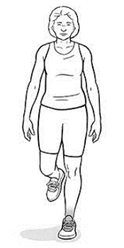
Single leg balance:
- Stand with your legs straight at shoulder width apart.
- Now lean slightly to the side and at the same time bend your opposite knee.
- You can make this more difficult by bending further but only within the limits of your mobility.
- PROGRESSIONS:
- Introduce uneven surfaces to stand on (bosu-ball, wobble cushion, rolled up towel/mat).
- Close eyes.
- Throw and catch ball whilst on one leg.
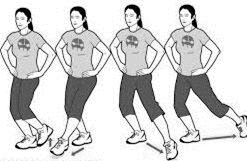
Toe taps:
- Stand up straight close to a wall or solid supporting surface.
- Stand only on one leg, using the wall to balance as needed.
- Try to let go of the wall while keeping your balance.
- Ensure you keep your gaze straight ahead, and your thigh and buttock muscles strong.
- Using your other foot, try to tap the floor around you with your toes.
- Imagine you are trying to touch the numbers of a clock face.

Single leg hopping:
- Stand on one leg.
- Spring up high into the air, hopping forwards, and landing softly on the same leg.
- Repeat the movement by hopping backwards, then to one side, and then to the other.
- The balls of your feet should be the first thing to land on the floor, followed by your heel, then a bend of your knee.
Ball stop:
- Roll a ball towards you child - slow = easy, fast =hard.
- Ask your child to stop the ball with their foot on top of the ball.
- Hold this position for 3 seconds before placing the foot back down on the floor.
- To make it harder increase time with foot resting on ball.
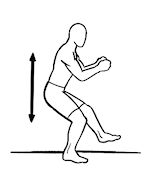
Single leg squat:
- Stand near a wall or table for support if you need it.
- Balance on your affected leg.
- Keeping the heel on the ground, bend your knee, ensuring the knee travels directly forwards over your toes.
- Straighten back up fully and repeat the movement.
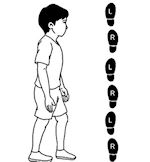
Tandom walking:
- Stand up straight with a clear path in front of you.
- Imagine a straight line on the floor extending away from you or place a straight line of tape along the floor.
- Walk along this line on the floor as if you are walking a tightrope.
- Try to step each foot just in front of the toes of the other foot.
- Try to maintain your balance and keep your feet stepping in the middle of the line.
Standing - rolling ball 360 degrees around standing leg:
- Stand up straight and place a ball under one foot.
- Roll the ball completely around your stance leg, so that you end up in the starting position.
- This exercise can help to strengthen the leg you are standing on and help with your balance and coordination.
How to progress balance exercises:
Introduce uneven surfaces to complete above exercises on:
- Bosu ball.
- Wobble cushion.
- Rolled up towel/mat.
- Multi-task – count up on twos or threes, count backwards from 20, say the alphabet backwards while doing physical tasks.
- Close eyes and do the physical exercises – with supervision of an adult.
The above exercises can improve coordination as well as balance!
Exercises to improve coordination
Drop and catch in standing:
- Stand holding a ball in one hand.
- Lift your hand out to the side to shoulder level and bend your elbow to 90 degrees so that your fingers are pointing forward, and your palm is facing down.
- Drop the ball and immediately catch it before it falls.
- Repeat this until you get tired or for as long as advised.
- To increase the difficulty of the exercise you can move your arm so that it is vertical, and your hand is pointing towards the ceiling, and return to catch the ball.

Throwing and catching beanbag/ball
- Stand up straight with the bean bag in one hand.
- Throw it up a little way and catch it with 2 hands -> progression to one hand if able.
- Try throwing a little higher and catching it.
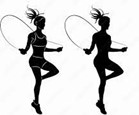
Jumping rope
- Single leg hops as progression:
- Double swings in one hop.

Throwing (target practice)
- Stand up straight holding a ball in your hand.
- Set up 5 empty bottles/cans on a platform.
- Take a few steps back from the bottles/cans.
- Step the opposite foot to your throwing hand forward.
- From this position, throw the ball at the bottles/cans to try and knock them down.
- Use the strength in your buttock and core muscles to rotate around, generating more force in your throw.
Walking whilst bouncing small ball:
- Stand up straight with a clear path in front of you.
- Walk in a straight line at your normal speed.
- Bounce a ball with one hand whilst continuing to walk in a straight line.
How to progress coordination exercises:
- Add more distractions.
- Multi-task e.g. counting up in twos or threes
- Smaller balls/smaller objects.
Please also see information on How to Get Active locally in the community.
Further printable balance exercise sheets
Last updated20 Jan 2025

